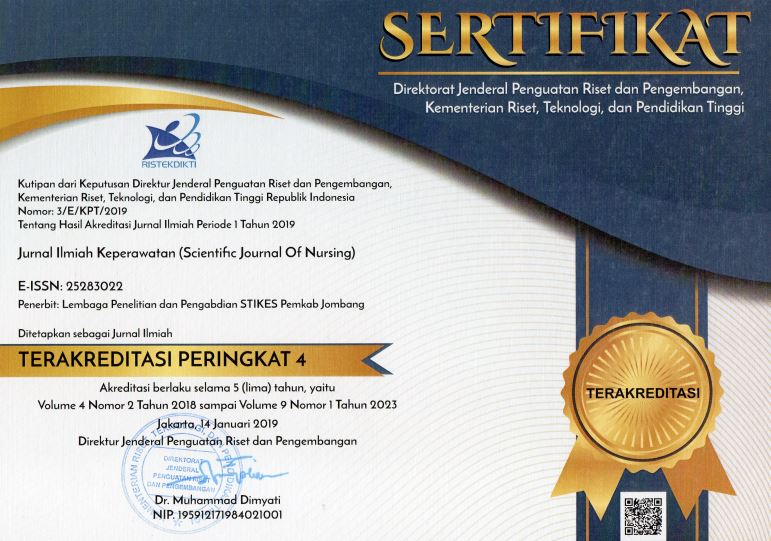EFEKTIVITAS PEMBERIAN LIDAH BUAYA PADA PASIEN LUKA BAKAR DI DESA YOSOWILANGUN LUMAJANG
The Effectiveness of Giving Aloe Vera to Burn Patients in Yosowilangun Lumajang
DOI:
https://doi.org/10.33023/jikep.v7i1.554Keywords:
Luka Bakar, Aloe vera, Obat TradisionalAbstract
ABSTRAK
Pendahuluan : Luka bakar merupakan salah satu trauma yang sering terjadi dalam kehidupan sehari-hari. Salah satu terapi luka bakar saat ini adalah dengan mengoleskan hidrogel sebagai obat topikal. Namun, hal ini membuat perawatan luka bakar mengeluarkan biaya yang mahal sehingga dibutuhkan aloe vera (lidah buaya) sebagai terapi obat tradisional yang efektif dan biaya yang di keluarkan lebih terjangkau. Tanaman lidah buaya merupakan tanaman obat tergolong keluarga Liliaceae, mempunyai potensi yang cukup besar sebagai bahan baku obat alami. Pemanfaatan tanaman obat sejak dulu telah dilakukan oleh masyarakat khususnya warga desa yang diperoleh dari warisan leluhurnya. Tujuan : Penelitian ini bertujuan untuk mengidentifikasi efektivitas pemberian lidah buaya pada pasien luka bakar di Desa Yosowilangun. Metode : Penelitian dilakukan melalui metode penelitian kuantitatif melalui pendekatan studi deskriptif. Informan dalam penelitian ini adalah masyarakat Desa Yosowilangun yang mengalami luka bakar dengan menggunakan lidah buaya sebagai obat tradisional. Hasil dan Simpulan : Penelitian ini didapatkan gambaran efektivitas pemberian lidah buaya pada pasien luka bakar. Aloe vera diberikan untuk mengobati pasien luka bakar derajat pertama dan derajat kedua, bila dibandingkan dengan perawatan luka konvensional maka Aloe vera lebih efektif untuk mempercepat proses penyembuhan dan epitelisasi jaringan kulit.
Kata Kunci: Luka Bakar, Aloe vera, Obat Tradisional.
ABSTRACT
Background : Burns is a trauma that often occurs in daily life. One of the current burn therapies is to apply hydrogel as a topical medication. However, this makes the treatment of burns an expensive cost so that Aloe vera is needed as an effective traditional medicine therapy and the cost is more affordable. Aloe vera plant is a medicinal plant belonging to the family Liliaceae, has considerable potential as a raw material for natural medicine. The utilization of medicinal plants has long been carried out by the community, especially villagers obtained from their ancestral heritage. Objective : This study aims to identify the effectiveness of giving aloe vera to burn patients in Yosowilangun Village. Methode : The research was conducted through quantitative research methods through a descriptive study approach. The informants in this study were Yosowilangun Village people who suffered burns using aloe vera as traditional medicine. Result : This research is be able to illustrate the effectiveness of aloe vera administration in burn injury patients. Aloe vera is given to treat first-degree and second-degree burn patients, compared to conventional wound care, Aloe vera is more effective in accelerating the healing process and epithelialization of skin tissue.
Keywords: Burns, Aloe vera, Traditional Medicine.
Downloads
References
Abidin, Z. (2019). Pemanfaatan Tanaman Obat dalam Mengatasi Keluhan Kesehatan pada Kelompok Tani Tebu Jatiroto Lumajang. The Indonesian Journal of Health Science, 11(1), 9-21.
Agoes, A. 2013. Tanaman Obat Indonesia - Profil Balai Besar Penelitian dan Pengembangan Tanaman. Jakarta: Salemba Medika.
Departemen Kesehatan RI. 2000. Parameter Standar Umum Ekstrak Tumbuhan Obat. Jakarta: Departemen Kesehatan RI.
Direktorat Obat Asli Indonesia. 2007. Acuan Sediaan Herbal. Vol.3. Edisi 1: Badan POM RI
Dwisatyadini, M. 2017. Pemanfaatan Tanaman Obat untuk Pencegahan dan Pengobatan Penyakit Degeneratif. Optimalisasi Peran Sains dan Teknologi untuk Mewujudkan Smart City 2, 237-270.
Harnilawati. 2013. Konsep dan Proses Keperawatan Keluarga. Sulawesi Selatan: Pustaka As-Salam.
Hidayat, Noer & Rizaliyana. 2013. Role of Topical Extract Aloe Vera gel in Deep Burn Wound Healing in Rat. Media Jurnal Rekonstruksi & Estetik Volume : 2 - No. 2 Terbit : 12-2013
Khorasani, G., S.J. Hosseinimehr, M. Azadbakht, A. Zamani and M.R. Mahdavi. 2009. Aloe versus silver sulfadiazine creams for second- degree burns: a randomized controlled study. Surg. Today, 39:587- 591.
Kurdi, F., Kholis, A. H., Hidayah, N. and Fitriasari, M. (2020) “STRESS PASIEN DENGAN ULKUS KAKI DIABETIKUM DI AL HIJRAH WOUND CARE CENTER JOMBANG: The Study of Stress Patients With Diabetic Ulcers in Al Hijrah Wound Care Center”, Jurnal Ilmiah Keperawatan (Scientific Journal of Nursing), 6(1), pp. 128-136. doi: 10.33023/jikep.v6i1.577.
Madan, Sharma, Inamdar, Rao & Singh. 2008. Immunomodulatory Properties of Aloe vera Gel in Mice,” International Journal of Green Pharmacy, Vol. 2, No. 3, 2008, pp. 152-154
Mangku G, Senapathi TGA. 2010. Buku Ajar Ilmu Anestesia dan Reanimasi. Jakarta: Indeks.
Moenadjat, Y. 2003. Luka Bakar Pengetahuan Klinik Praktis. Edisi II. Jakarta: Fakultas Kedokteran UI.
Moenadjat, Y. 2009. Luka Bakar Masalah dan Tatalaksana. Jakarta: Balai Penerbit FKUI.
Perhimpunan Dokter Spesialis Anestesiologi dan Terapi Intensif Indonesia. 2009. Panduan Tatalaksana Nyeri Operatif. Jakarta: PP IDSAI.
Ramachandra and Rao. 2008. Processing of Aloe Vera Leaf Gel: A Review. Am. J. Agril. & Biol. Sci., 3 (2): 502-510, 2008.
Setiadi. 2007. Konsep dan Penulitan Riset Keperawatan. Yogyakarta: Graha Ilmu.
Sudarto, Y. 1997. Lidah buaya. Kanisius. Yogyakarta.
Yudiyanta, Novita. 2015. Assessment Nyeri. Patient Comfort Assessment Guide.
Published
How to Cite
Issue
Section
Authors who publish with Jurnal Ilmiah Keperawatan (Scientific Journal of Nursing) agree to the following terms:
- Authors retain copyright and grant Jurnal Ilmiah Keperawatan (Scientific Journal of Nursing) the right of first publication with the work simultaneously licensed under a Creative Commons Attribution 4.0 International License that allows others to remix, adapt and build upon the work with an acknowledgment of the work's authorship and of the initial publication in Jurnal Ilmiah Keperawatan (Scientific Journal of Nursing).
- Authors are permitted to copy and redistribute the journal's published version of the work (e.g., post it to an institutional repository or publish it in a book), with an acknowledgment of its initial publication in Jurnal Ilmiah Keperawatan (Scientific Journal of Nursing).









